Vol 3 No. 39 TROPIC LIGHTNING NEWS September 23, 1968
Index
Record Civic Action Program
3D BDE - With the lull in fighting near Saigon
continuing all
during the month of August, the 3d Brigade has turned some of its attention on a
record program of civic action.
A massive outpouring of medical help, rebuilding of schools and
roads, and a popular series of Country Fairs highlighted activities by the
brigade’s four battalions of infantry and one of artillery.
More than 12,000 Vietnamese were treated during 102 medical
civic action programs (MEDCAPs) by medics of the 2d Battalion, 12th
Infantry; 2d Battalion (Mech), 22d Infantry; 4th Battalion, 9th Infantry; 1st
Battalion, 27th Infantry, and 2d Battalion, 77th Artillery.
As part of village improvement efforts in hamlets scattered
near Tan Son Nhut airbase, brigade units distributed 6,000 lbs of cement, 67
gallons of paint, 861 board feet of lumber, 146 sheets of tin roofing, and 2,450
lbs of other building materials.
During the County Fairs and other civic action events, the
“Tropic Lightning” infantrymen distributed 18,530 lbs of food and 2,300 lbs
of clothing. Also handed out were 465 lbs of health items.
In the village of Vinh Thanh, five miles northwest of the capital,
Manchus of the 4th of the 9th painted a marketplace and also helped the villagers by
providing paint for them to restore the finish of their two brightly colored
Cao Dai temples. The village is unique in the area for being virtually 100
per cent Cao Dai.
At other nearby villages, the same battalion screened in three
dispensaries used for its MEDCAPs.
In the hamlet of Ba Diem, the 2d of the 12th White Warriors
repaired a roof and fence at the community school, then put up a new gate.
Meanwhile the 1st of the 27th Wolfhounds dug a new well and repaired a water
pump at the hamlet of Ap Sau.
In all, there were more than 30 such individual construction
projects included in the month’s civic action accomplishments.
Simultaneously, during the civic action programs and at 16
marketplaces daily, psychological operations teams were broadcasting messages
urging villagers to support the government and offering tips on battling
plague and other health problems. The PSYOPS teams also stressed traffic safety.
“We’ve been getting a lot of help and cooperation from district
chiefs and other local officials,” said Sergeant First Class John Johnston of
Saugus, Mass., brigade civic affairs noncommissioned officer in charge.
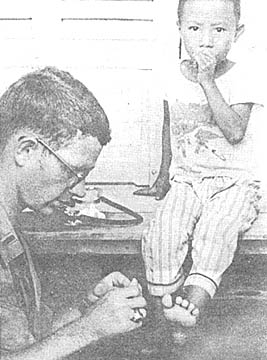 |
HOLEY TOE, BATMAN - A young Batman fan who is temporarily immobilized by a cut on his foot receives first aid in the form of a band-aid from First Lieutenant Richard Booth of Anaconda, Mont., assistant medical operations officer of the 3d Battalion, 22d Infantry. (PHOTO BY SP4 HERB BURDETT) |
Hounds Blast NVA, Ambush Kills Seven
2D BDE - Tropic Lightning soldiers from the 2d Battalion, 27th
Infantry, tallied seven enemy killed and a large variety of weapons captured
when they engaged a platoon-sized element of NVA soldiers.
Specialist 4 Levi Simmons, a grenadier from Jamaica, N.Y.,
reported that, “I had been watching the two men at my left put out their
claymores. When they returned, we were choosing who would pull the first
guard. Suddenly I noticed eight figures approaching our position.
I pointed them out to the others around me.”
Specialist 4 John De Robertis triggered the Wolfhound ambush by
detonating both of the claymores.
A thorough search of the area the next day revealed seven NVA
soldiers dead. Also, four suspects were detained. Four automatic
assault rifles, four shoulder-carried rocket launchers, 2,000 rounds of small
arms ammo, 14 RPG rounds, eight Chicom hand grenades, one antitank mine, one
Chicom 9mm pistol and a bag of medical supplies were captured.
Soldier Gets Vietnamese Decoration
3D BDE - Specialist 4 John Saffo of St. Louis, Mo., has been
awarded the Gallantry Cross with Bronze Star by the South Vietnamese government
for his part in an action termed by his company commander “the most successful
small unit action in our company’s history.”
Company D, 3d Battalion, 22d Infantry, was conducting a
reconnaissance-in-force a few miles north of Saigon when they ran into a well
entrenched force of NVA in the banks of a canal.
After calling in air strikes the 25th Div. infantrymen assaulted
the bunker complex killing 14 NVA without suffering a single casualty. “I was attempting to outflank the
enemy position by tossing hand grenades
into their bunkers when I realized I needed someone to cover the rear”, said
Platoon Sergeant Robert Nelson of Hannibal Mo. “I asked for
volunteers.”
“I just jumped up and started spraying the area with my
M-16,” said Saffo. “I fired at every bunker we passed in an effort to
protect Nelson.”
“He sure did” replied Nelson as he congratulated Saffo, who was
beaming from ear to ear with pride in his award.
More Than 73 Tons
Resupply Hectic For 3/22
1ST BDE - The support platoon of Headquarters,
Headquarters
Company, 3d Battalion, 22d Infantry, resupplied the battalion’s units in the
field with more than 73 tons of ammunition during a recent hectic three days
which saw the lull in the Vietnam fighting come to an abrupt halt.
A battalion sized Viet Cong and North Vietnamese Army force had
struck at the Fire Support Base Buell II, four miles north of Tay Ninh. “I knew what that meant for me and my people”, said Lieutenant Jan K.
Pierson of Hackensack, N.J., platoon leader for the support platoon, “We would
be working around the clock and then some to resupply the base.”
Specialist 4 Jack Garland of Houston, Tex., had been working with
the platoon for over six months but he was still a little anxious that night.
“I couldn’t remember the last time we mishandled a Chinook load of ammo, but
I was more than just a little bit concerned that night. We had to resupply
tons of ammo and we had to do it quickly.”
Specialist 4 Rick Umlauf of Goldendale, Wash., was in charge of
drawing ammo and definitely had his work cut out for him. “I knew they
would need ammo and need it fast.” We had several thousand rounds of
various types of ammo on hand that could be shipped out right away, but we still
had to requisition much more. In fact we even had to request emergency
resupply requisitions to get the ammo we needed,” he said.
“Then the news reached us that our Alpha Company had been
attacked up on Nui Ba Den,” said Pierson, “and that we would also have to
supply .50 caliber rounds to the units at Dau Tieng. All of this had to be
done in addition to our normal resupply duties of providing food, and water for
our troops in the field.”
The 3d Battalion, 22d Infantry, crew worked all that night, all the
next day, plus “overtime” on the day following. “The ammunition
went out by Hueys, by Chinooks and also by flying cranes,” said Specialist 4
Elroy Conway of Albuquerque, N.M. Conway was in charge of the slings and
rigging. He also made sure that the loads were secured correctly and had
the tricky task of attaching each load to the Chinooks and Flying Cranes.
During those hectic days the 3d Brigade, 25th Infantry Division
support people shipped 118,000 M-16 rounds; 100,000 .50 caliber rounds, 72,000
M-60 machine gun rounds, 935 81mm and 700 4.2 inch mortar rounds, 3,300 M-79
rounds and more than a thousand fragmentation grenades. The total exceeded 73
tons.
| RESUPPLY - A Flying Crane waits in the wings as a Chinook carries a “water buffalo” to 3d Battalion, 22d Infantry Regulars, at Fire Support Base Buell II four miles north of Tay Ninh City. (PHOTO BY SP4 HERB BURDETT) | 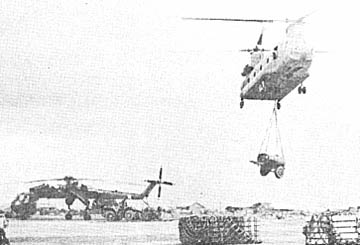 |
Div Pilot Saves Hit VN Pilot
CU CHI – A 25th Infantry Division helicopter pilot took his
unarmed craft down into a heavy barrage of enemy .50 caliber bullets to rescue a
Republic of Vietnam (RVN) Skyraider pilot downed five miles southeast of Cu Chi.
Captain Barry W. Lambert from Ekron, Ky., the aircraft maintenance
officer of Company A, 25th Aviation Battalion, and Staff Sergeant Garry K.
Paris from Canton, Tex., maintenance supervisor, were airborne in a Huey on
a routine test flight when they spotted three Skyraiders on a bombing run.
As they watched, one of the Skyraiders, hit by .50 caliber fire,
crash-landed into a swamp only yards from the bunker complex it had been
bombing. Making a pass over the downed aircraft, Lambert saw the pilot
crawling along the wing.
Lambert pointed his Huey at the Skyraider and rapidly descended.
A volley of .50 caliber bullets rained out from the bunker complex
and forced Lambert to whip through one evasive maneuver after another.
As the bullets splashed in the murky water around and beneath the
Huey, the Vietnamese pilot slid off the wing, swam to the waiting helicopter and
crawled aboard. The Huey zoomed back into the sky and headed for Cu Chi.
|
Bulletin At press time for this paper the Viet Cong were dealt another resounding defeat by the 25th Infantry Division. For the second time in less than a month, the enemy attempted to push into heavily populated areas of Tay Ninh Province. |
Page 2 TROPIC LIGHTNING NEWS September 23, 1968
Decorated
|
BRONZE STAR MEDAL |
|
|
LTC DONALD M. EDWARDS, 25th Admin Co MAJ FRANCIS G. LEE, HHC, 25th Inf Div CPT DENNIS G. O’LEARY, HHC, 25th Inf Div CPT JAMES F. OAKS, HHC, 25th Inf Div CPT ROLAND D. BOLLACKER, HHC CPT JAMES A. TOWN, HHC 1LT DAVID R. AYERS, Co B, 2nd Bn, 12th Inf 1LT THOMAS E. HIRSCH, Co A, 4th Bn (Mech), 23rd Inf W02 CHARLES P. EASTES, D Trp, 3d Sqdn, 4th Cav 1SG JAMES T. SILLS, Co B, 2nd Bn (Mech), 22nd Inf PSG BOB H. SMITH, Co B, 2nd Bn, 12th Inf PSG ADMIRAL J. BOWSER, Co B, 2nd Bn, 12th Inf SFC-ROBERT E. MARSEE, HHB, 25th Inf Div Arty SSG RICHARD JACOBS, HHC, 2nd Bde SSG JOHN A. FARMER, HHD, 125th Sig Bn SSG WILLIE A. MYERS, HHC, 65th Engr Bn SSG LARRY W. FRANKLIN, HHC, 2nd Bde SSG ROBERT W. RYBASKIK, 25TH MP Co SSG RICHARD E. PIVER, Co C, 65th Engr Bn SGT JOHN A. WARDROBE, Co D, 2nd Bn, 12th Inf SGT MARTIN KELLY, Co A, 2nd Bn, 27th Inf SGT SHEDRICK WILLIAMS JR., Co A, 2nd Bn, 27th Inf SGT JESSE L. B. SOTEIO, Co A, 4th Bn (Mech), 23rd Inf SGT GARY A. HANSEN, Co A, 4th Bn (Mech), 23rd Inf SGT DANIEL JOUDREY, Co B, 2nd Bn, 27th Inf SGT LARRY HENSLEY, Co C, 1st Bn (Mech), 5th Inf SGT SHED B. WADDY, Co B, 2nd Sn, 12th Inf SGT ELBERT T. COLLEY, Co B, 2nd Bn, 12th Inf SGT EUGENE J. CARBTREE, Co A, 4th Bn (Mech), 23rd Inf SGT LARRY G. LEE, Co A, 4th Bn (Mech), 23rd Inf SGT RICHARD W. ROGERS, Co B, 2nd Bn, 27th Inf SGT DONALD F. GREEN, Co A, 4th Bn (Mech), 23rd Inf SGT BILLY J. KIRBY, Co A, 4th Bn (Mech), 23rd Inf SGT CHARLES L. BARNETT, Co A, 4th Bn (Mech), 23rd Inf SGT PAUL D. LATIMER, Co B, 2nd Bn (Mech), 22nd Inf SGT BRUCE K. MURWIN, Co B, 2nd Sn, 12th Inf SP5 DANIEL V. ROPER, HHD, 125th Sig Bn |
SP5 DAVID R. KRAUS, 25th Admin Co SP5 WILLIAM D. SKINNER, HHC, 2nd Bde SP5 DAVID W. BOLLINGER, HHC, 2nd Bn (Mech), 22nd Inf SP5 DENNY R. HEAD, HHC, 2nd Bn (Mech), 22nd Inf SP5 JOHN C. LAUNER, Co B, 2nd Bn, 12th Inf SP5 JERRY A. MC KINNEY, HHC, 1st Bn (Mech), 5th Inf SP5 LUCIAN R. KROHLING, Co D, 2nd Bn, 27th Inf SP5 STEVEN W. WELKER, Co B, 2nd Bn, 27th Inf SP5 JOHN A. SHEPPERSON, Co A, 4th Bn (Mech), 23rd Inf SP5 THOMAS VAN HOY, Co A, 4th Bn (Mech), 23rd Inf SP5 THOMAS A. TALARICO, HHC SP4 LOUIE G. CURIEL, Co C, 65th Engr Bn SP4 ALLAN R. MC GUIRE, HHC, 2nd Bn (Mech), 22nd Inf SP4 ROBERT J. MISEVICH, HHC, 2nd Bn (Mech), 22nd Inf SP4 CLAY R. ATCHISON, Co B, 2nd Sn, 12th Inf SP4 WILLIAM J. CURA, Co B, 2nd Bn, 12th Inf SP4 ARTHURO DE LA OSSA, Co B, 2nd Bn, 12th Inf SP4 VINCENT P. DIMARZO, Co B, 2nd Bn, 12th Inf SP4 JOY L. HODGES, Co B, 2nd Bn, 12th Inf SP4 PAUL R. NEWMAN, Co B, 2nd Bn, 12th Inf SP4 JOHN W. SMITH, Co B, 2nd Bn, 12th Inf SP4 MARSHALL A. TEMPLE, Co B, 2nd Bn, 12th Inf SP4 JULIO BALANDRAN, Co C, 1st Bn (Mech), 5th Inf SP4 TERRY L. KOHLER, Co C, 1st Bn (Mech), 5th Inf SP4 JOHN B. CHENAULT, Co C, 2nd Bn, 27th Inf SP4 GEORGE E. LAWYER, Co D, 2nd Bn, 27th Inf SP4 JOHN A. LOFTUS, Co A, 2nd Bn, 27th Inf SP4 DAVID E. MARTIN, Co D, 2nd Bn, 27th Inf SP4 LARRY N. SKUBOVIUS, Co A, 2nd Bn, 27th Inf SP4 RONALD L. SOMPLE, Co A, 2nd Bn, 27th Inf SP4 GARY L. PHILLIPS, Co A, 2nd Bn, 27th Inf SP4 JOHN P. RIES, HHC, 2nd Bde SP4 WAYNE T. SINCLAIR, Co D, 2nd Bn, 12th Inf SP4 THOMAS MADRID, HHC, 3d Bde, PFC JOSEPH HAYES, Co B, 2nd Bn, 12th Inf PVT WILLIAM M. HENDERSON, Co C, 1st Bn, 27th Inf |
Larger Pay For Disabled Vets In Jan.
Approximately 1,952,000 service-disabled veterans will receive
increased compensation payments beginning next January under a bill signed
into law last month by President Johnson.
Some 112,000 veterans with 100 per cent service-connected
disabilities will have their payments increased from $300 to $400 a month.
Payments will be increased eight per cent for about 1,840,000 veterans with 10
to 90 per cent service-connected disabilities.
The new law also authorizes the Administrator of Veterans Affairs
to provide invalid lifts, other therapeutic or rehabilitative devices, and
medical equipment and supplies to eligible veterans. This provision be came
effective when the bill was signed.
The increased rates will be reflected in the January 1969
disability compensation checks.
 General Urges Vote General Urges Vote“The right to vote is a basic American heritage that our forefathers fought for and won nearly two hundred years ago. “This is also our primary reason for being here - to protect this right, one which cannot be enjoyed by peoples living throughout the world under Communism. All eligible personnel should exercise this right. “It is my desire that all personnel who desire to vote are given the necessary information concerning the requirements in their particular State or Territory, and are assisted in preparing the Federal Post Card Application. Subsequently, assistance will be given in preparing their ballot for mailing, if desired.” Maj. Gen. Ellis Williamson |
Xmas Mail Date Set
The Department of Defense and the Post Office Department have
announced the suggested dates for mailing Christmas cards and gifts to
servicemen overseas.
The mailing dates are: surface mail, Oct. 14 to Nov. 9; space
available mail (SAM), Oct. 21 to Nov. 23; parcel air lift (PAL), Oct. 28 to Nov.
30; and air mail, Nov. 30 to Dec. 11.
Mailing within the dates outlined will insure timely delivery to
the overseas destination.
By using the SAM and PAL services, senders can save in the cost of
shipping packages.
Be sure to wrap packages securely and address them correctly,
using the APO or FPO number. (ANF)
Tropic Lightning
Combat Honor Roll
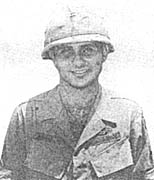 This month, Major General Ellis W. Williamson, Commanding General
of the 25th Infantry Division, initiated a program to spotlight, each week,
the soldier who has exhibited the characteristics and traits representative of
the spirit of the American Fighting Man.
This month, Major General Ellis W. Williamson, Commanding General
of the 25th Infantry Division, initiated a program to spotlight, each week,
the soldier who has exhibited the characteristics and traits representative of
the spirit of the American Fighting Man.
The first soldier to be placed on the Tropic Lightning Honor Roll
is Sergeant E-5 Angelo L. Anselmo, US54510775, of Headquarters a n d
Headquarters Company, 2d Battalion, 27th Infantry.
Sergeant Anselmo distinguished himself by heroic actions while
serving as an assistant squad leader with the Combined Reconnaissance and
Intelligence Platoon, 2d Battalion, 27th Infantry in the Republic of
Vietnam.
While on a combat operation, the C.R.I.P. was ambushed by an
enemy force. During the initial contact, Sergeant Anselmo was pinned
down by hostile machine gun fire. Spotting three enemy soldiers
assaulting his position, Sergeant Anselmo, with complete disregard for his own safety, exposed himself to the charging hostile soldiers as
he killed all three of them.
Although wounded in the leg by an exploding RPG round, he ignored
the wound, crawled through withering enemy fire and destroyed a hostile machine
gun emplacement which had been placing effective fire on his squad.
Sergeant Anselmo remained in his exposed position providing
suppressive fire allowing his squad to withdraw to safety. His valorous
action contributed immeasureably to the defeat of the enemy force and the
success of the mission.
Sergeant Anselmo’s personal bravery, aggressiveness and devotion
to duty are in keeping with the highest traditions of the military service and
reflect great credit upon himself his unit, the 25th Infantry Division and the
United States Army.
The TROPIC LIGHTNING NEWS is an authorized publication of the 25th
Infantry Division. It is published weekly for all division units in the Republic of
Vietnam by the Information Office, 25th Infantry Division, APO San Francisco
96225. Army News Features, Army Photo Features, Armed Forces Press Service and Armed
Forces News Bureau material are used. Views and opinions expressed are not necessarily
those of the Department of the Army. Printed in Tokyo, Japan, by Pacific Stars and
Stripes.
MG Ellis W. Williamson . . . . Commanding General
MAJ Andrew J. Sullivan . . . Information Officer
2LT Don A. Eriksson . . . . . . Officer-in-Charge
SP4 Bill Berger . . . . . . . . . . . Editor
Page 3 TROPIC LIGHTNING NEWS September 23, 1968
159 Medals Go To 2/22
3D BDE - The men of the 2d Battalion (Mechanized), 22d Infantry,
were presented 159 medals by their outgoing commander, Lieutenant Colonel King
J. Coffman of LaCrescenta, Calif.
The awards presented by Coffman had been earned by his 3d Brigade
soldiers during May and June, while the Triple Deuce was engaged in road
sweeping operations in Tay Ninh province.
Included were valor and service awards of the Bronze Star and
Army Commendation Medal, plus Purple Hearts.
Speaking to his men at the time of his departure, Coffman said,
“I am no hero, but I had the honor of commanding a battalion of heroes.”
During the time of Coffman’s command the Triple Deuce fought 23
battles, including an extended three-day battle in War Zone C over Easter
weekend. The battalion’s tally for the period was 247 enemy killed, 28
rifles, nine rocket launchers, two recoilless rifles and three .51 caliber
machine guns.
The tall, lanky Coffman, who was readily identifiable by the
machinegun headspace and timing gauge in his collar button-hole, goes home to
a well-earned rest, and will then proceed to the Pentagon for a new assignment
in the Office of the Army Chief of Staff.
Soldiers Teach English In Bac Ha
Story and Photos By SP4 Richard Patterson
CU CHI - “This is a book. The sky is blue. This is a
pencil.”
These are simple English phrases from the mouths of children.
But wait a minute. There is something unusual.
The classroom is sparsely furnished with wooden benches, and there
is only one text book for every two students. The voices are those of
Vietnamese children, and the teacher is dressed in jungle fatigues. This
is indeed an unusual classroom.
The school is the Minh Tan High School in the Village of Bac Ha and
the teacher is U.S. Army Private First Class John E. Young, a laboratory
technician
in the 12th Evacuation Hospital at the 25th Infantry Division’s base camp
at Cu Chi.
Every Saturday morning Young, of Reno, Nev., and Specialist 4
Robert J. Dubi, of Chicago, Ill., leave the base camp and travel three miles to
the school to teach English to Vietnamese youngsters.
“When I first started teaching,” explained Young, “I was a
little apprehensive, but now I wouldn’t give it up for anything. These
kids and I get along great, and it’s such a wonderful feeling to help them.”
According to Young, Father Phan, head of the school, asked him if
he would teach the children English. Young “jumped at the chance to do
something for these people,” and the program began.
The high school students were being taught text-book English by
their teacher, Nguyen Van Hue; but there were many sounds that the children
could not pronounce correctly.
“That’s where I came in,” said Young, a 1967
graduate of the University of Nevada. “I am able to give the kids the correct
pronunciation of such words as ‘this’. There are no Vietnamese sounds
comparable to ‘th’,” Young explained.
As Young became involved with teaching and started receiving some
of his old English text books from home, Dubi became more interested in the
project and finally received permission to accompany Young.
Both GI’s work all day Sunday and sometimes at night so they can
teach on Saturday morning without falling behind in their regular duties.
Dubi did not know exactly who he would teach and his first day at
the school was quite an experience.
The younger children, many with older brothers and sisters learning
English in Young’s class, pestered Father Phan so much that he finally agreed
to let them learn English also.
Two elementary classes were combined into one large group for the
special lessons with an American GI and Dubi walked into a classroom where 62
eager faces watched every move he made and listened attentively to every word he
spoke.
“When I saw all those kids relying on me to teach them English I
was a little unsure of myself,” Dubi admitted, “but just about everything is
working out perfectly.”
Young and Dubi agree that the language barrier is one of their
biggest problems. “I need Lai Van Doan to interpret for me sometimes.
He is the regular teacher for my class and speaks a little English. But
once in a while we get all mixed up,” Dubi confessed.
 |
BEGINNING WITH BASICS - Specialist 4 Robert Dubi pronounces the English words he has just printed on the blackboard. The class pronounces the sentence several times and then writes the words down in note books. |
| HANDY INTERPRETER - A Vietnamese teacher follows the translation in a text book while Private First Class John Young pronounces an English word for the class. |  |
Ambush Kills Two
2D BDE - Tropic Lightning soldiers from the 2d Battalion, 27th
Infantry Wolfhounds were just nearing their ambush site when they heard voices.
The 1st Platoon of Company C set up a hasty ambush and waited.
Sergeant Joe 0. Donnell of Peckville, Pa., reported: “We
stayed there and waited as the enemy approached. The point man was three
feet from me when I opened up on him.”
The ambush left two enemy dead and seven sets of enemy web gear,
two assault rifles, a carbine, and an M-79 launcher.
 |
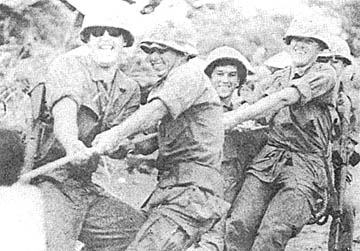 |
| TUG OF PEACE - When 25th Division infantrymen began to dismantle a temporary rope railing following a civic action program, youngsters at a village seven miles northwest of Saigon engaged them in a tug of war. The contest quickly turned into a lopsided rout, as the outnumbered soldiers of the 2d Battalion, 12th Infantry, were swept toward the edge of town by the jubilant, kids. It was the first known “surrender” by the 3d Brigade White Warriors in the history of the Vietnam conflict. Soldiers from left are Specialists 4 Richard E. Anderson of Alta, Ia., Henry D. Towns of Calvert, Texas., Arlyn D. Olson of Proston, Minn., and twin brothers Jerry L. and Terry B. Weigold of Marquette, . Mich. (PHOTO BY SP4 CHARLES HAUGHEY) |
Page 4-5 TROPIC LIGHTNING NEWS September 23, 1968
2D BDE BRIDGE DEFENSE
2D BDE - Protecting the major land routes from the 25th Infantry
Division base camp at Cu Chi to the main supply points at Tan Son Nhut, Long
Binh and Saigon has been a major concern of the Tropic Lightning Division’s 2d
Brigade.
Elements of the brigade are on constant alert at the Hoc Mon, Ba
Bep, Trang Bang, and Phu Cuong bridges to prevent enemy use and guard against
sabotage. In their efforts to keep the bridges safe, the brigade units
employ every known device.
Recently, the Navy’s Underwater Demolition Team 12 (UDT-12) spent
three days checking the concertina wire and reinforcement of the bridges.
Broken sections of wire and weak spots discovered by the team were repaired by
the men of the 2d Battalion, 14th Infantry, on duty at the bridge.
Close coordination between 25th Division and ARVN units helps to
make security of the bridges easier and more efficient. In cooperation
with defense units, Division Military Police establish checkpoints at the
various bridges from time to time along with Vietnamese National Police to
apprehend infiltrators and contraband weapons.
With bunkers at the bridge locations kept in good repair, the use
of armor and track vehicles, and alert sentries, the bridges can be well
controlled. Forty-millimeter duster from the Division Artillery provide a
big punch for the defense when enemy elements are encountered.
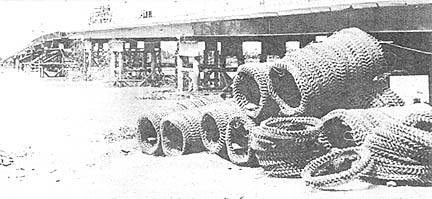 |
| Stacks of concertina wire await placement beneath the Phu Cuong bridge which spans the Saigon River. |
 |
| Concertina wire is strung around pilings at the Hoc Mon site. |
 |
Bunkers manned 24-hours-a-day are a vital part of the bridges’ defense. |
| Navy Seaman Mike C. Ferrell, Houston, Tes., prepares to make the initial inspection. | 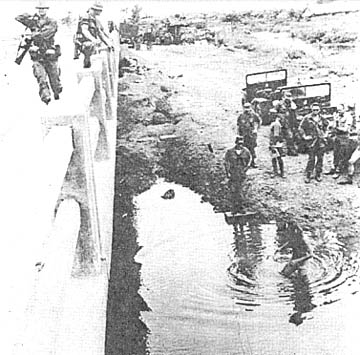 |
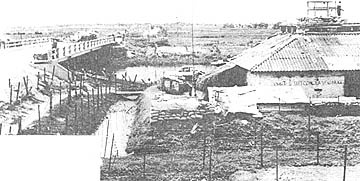 |
The task of defending the Hoc Mon bridge is shared by both the 2d Brigade and ARVN soldiers. |
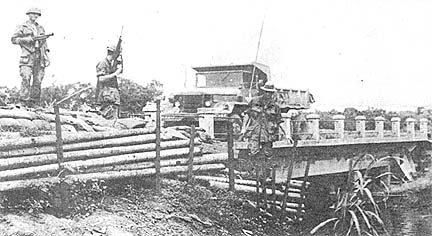 |
| Men from Company C, 2d Battalion, 27th Infantry, defend the Trang Bang bridge. |
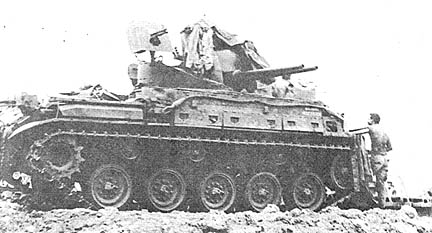 |
| The Ba Bep bridge is flanked by 40mm Dusters from Battery B, 5th Battalion, 2d Artillery. |
Page 6 TROPIC LIGHTNING NEWS September 23, 1968
Diamondhead’s Smokey Is An Infantry
Favorite
CU CHI - In the world they call it smog - and most people are
annoyed by it. In Vietnam, they call it smoke - and the infantrymen love
it.
Diamondhead helicopters of Company B, 25th Aviation Battalion,
create the smog in the area. The smoke dispensing helicopter,
appropriately named Smokey, is capable of laying a smoke screen by flying
low-level and dispensing smoke over the desired area.
Smokey is used to shield friendly elements by denying the enemy a
visual target, and can be effectively employed by ground forces or in airmobile
operations, day or night.
Diamondhead Smokey was used recently by one infantry unit to enable
them to evacuate wounded men. Enemy fire prevented the infantrymen from
getting to the wounded until Smokey screened them from the enemy’s view.
The smoke ship made numerous passes over and in front of the
enemy. Each time, Smokey received intense enemy fire. Continuing
even after darkness had fallen, Smokey made it possible for the friendly
elements
to recover their casualties and continue the offensive on the enemy positions.
In the airmobile concept, Smokey is employed to shield the
troop-carrying slicks in the landing zone and enable the inserted troops to
assume an offensive position. On one such mission recently, Smokey was
the first to discover that the landing zone was hot.
Asked about the intensity of enemy fire, Captain Jerry Boyington,
executive officer for the Diamondheads, said: “It was as it they were in the
back seat shooting at us.” Boyington really felt smoked when a round
passed through both of his boots. However, the wounds were minor, and he
was smoking for another combat assault two days later.
The statement “Smoking may be hazardous to your health”
certainly applies to flying the smoke ship since the crew must constantly expose
themselves to enemy fire to successfully complete their mission.
| LOVE THAT SMOG - A Diamondhead smoke ship from Company B, 25th Aviation Battalion, lays a smoke screen to shield infantrymen from the enemy’s sights. |  |
Mushy VC Love Letter Costly
1ST BDE - Once again a Vietnamese interpreter proved his value to
infantrymen as he used a love letter to identify two suspected female VC
sympathizers. Sergeant First Class Nguyen Dang Khoi, the chief
interpreter with the 4th Battalion (Mechanized), 23d Infantry Tomahawks, was
ambling around the battalion perimeter when two young women attracted his
attention.
The 1st Brigade interpreter asked the two women to produce the
official Vietnamese identification card, but they were unable to do so.
Khoi directed them to enter the U.S. position. Immediately the women were
searched and a letter was found on one of them.
The Tomahawk interpreter translated the letter - ”Why it’s a
mushy love letter,” joked Khoi. He continued translating, “Even better than
that, her boyfriend keeps making reference to his being a Viet Cong and having
taken part in numerous missions,” stated Khoi.
Hoi Chanh’s Tip Helps To Detain Seven
1ST BDE – Information from a Hoi Chanh triggered a chain of
events that resulted in the detention of seven Viet Cong suspects and the
capture of their platoon’s supply of weapons.
With the assistance of Hoi Chanh, soldiers from the 2d Platoon of
Company B, 2d Battalion, 14th Infantry, picked up three VC suspects in a village
six miles south of Cu Chi. Information obtained from the detainees
indicated there were others hiding nearby.
A thorough search of the area uncovered a bunker where additional
enemy soldiers might be hiding. The platoon’s point man, Private First
Class Ronald Hays of Rensselaer, Ind., began digging a hole in the top of the
bunker. “As soon as I got a good-sized hole in the bunker, two hands
shot up,” said Hays. “I jumped back and lowered my M-79 and three Viet
Cong suspects pushed their way up out of the bunker.”
From questioning of the three, the whereabouts of an armorer was
learned, and the Golden Dragons quickly surrounded the tunnel and tried to talk
him out. “As I looked down into the tunnel one of his arms was exposed
and when he showed no sign of coming on his own, I reached down and pulled him
out,” said Staff Sergeant Robert Keefer of Orlando, Fla.
After his extraction from the tunnel, the armorer led the Dragons
to his platoon’s supply of weapons which included 25 automatic rifles, two
light machine guns, and miscellaneous mortar equipment.
| WET AGAIN - Stream crossing comes naturally to men of Company C, 2d Battalion, 14th Infantry as they search for the enemy east of Cu Chi. Here, two infantrymen and a medic make their way through the murky water. (PHOTO BY SP4 LARRY WEIST) |  |
Find 5 Tons Of Rice
1ST BDE - More than five tons of rice were taken from the enemy
during a reconnaissance-in-force mission seven miles southwest of Go Dau Ha by
two companies of the 2d Battalion, 14th Infantry.
The rice, in 100 pound bags, had been carefully concealed in
sampans along the banks of a canal. Company A made the initial find.
“I jumped into a large covered sampan loaded with rice and
started checking it out, and I saw a man hiding behind some bags in the rear,”
recalled Specialist 4 Robert Smith, of Lima, Ohio.
When the man came out he was questioned by an interpreter and
detained as a VC suspect.
A thorough search of the area by Companies A and C
uncovered more than 100 bags of rice. Most of the rice was found in
sampans which were sunk after their motors were recovered.
The rice was lifted out by Chinook helicopter to Tay Ninh, where it
will be distributed to the populace.
Page 7 TROPIC LIGHTNING NEWS September 23, 1968
Mech Moves In
Enemy Moves Out
Leaving Ten Dead
Photos and Story By SP4 Denny Ellett
1ST BDE - Following up an intelligence report of NVA troops occupying Trung Hoa,
a small village less than a mile southeast of Tay Ninh City, the 4th Battalion
(Mechanized), 23d Infantry Tomahawks, moved in to rid the village of the dreaded
intruders.
Lieutenant Colonel Clifford C. Neilson, Tomahawk commander, used
the main road through the village to deploy the Tomahawks and elements of the
2d Battalion, 27th Infantry Wolfhounds. They were to sweep through the
village and meet a blocking force formed of elements of the 2d Battalion, 34th
Armor.
As the task force approached the village, Vietnamese Regional and
Popular Force (RF-PF) soldiers began to move onto the road. Realizing that
the RF-PF’s could be NVA in disguise, Neilson directed Staff Sergeant Nguyen
Van Dinh, a Tomahawk interpreter, to question the suspicious unit. He
reported that they were in fact RF-PF’s and learned that they were all that
was left of the force protecting the village when the NVA moved in.
Pushing into the village, interpreters questioned the civilian
populace and discovered that the NVA forces had taken refuge near the Cau Dai
temple. The 1st Brigade infantrymen continued preparing themselves
for the battle that was inevitable. When the task force reached the area
of the temple, they were surprised to see that this was also the place that the
villagers had chosen for protection.
The Tomahawks were beginning to think that the NVA had left
because the Vietnamese civilians were gathered so close to where the enemy force
was presumed to be. But, suddenly the NVA opened fire, showing no
regard for the civilians gathered between the two forces.
The task force backed up slowly hoping that they could evacuate the
innocent civilians from the area of contact.
When the villagers were out of the line of fire, the Tropic
Lightning force intensified their fire on the enemy positions. Darkness
approached, and the NVA showed no sign of slacking up.
The following day the Tomahawks acted as a blocking force while
the ARVN 51st Ranger Battalion and tanks from 2d Battalion, 34th Armor swept
through the area of contact. They received no enemy fire and learned that
during the night the NVA had fled dragging away their dead and injured.
 |
MOVE OUT - Tomahawks from the 4th Battalion (Mechanized), 23d Infantry, roll through Tay Ninh City after NVA infiltrators fled from the city. |
| REINFORCEMENTS - Elements of the Tomahawks secure a landing zone for the 2d Battalion, 27th Infantry moving to reinforce units near Tay Ninh City. | 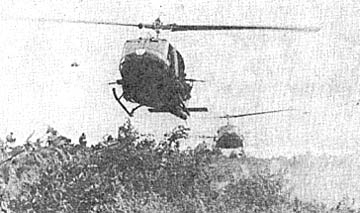 |
 |
SHOT OUT - A pair of Tomahawks from the 4th Bn (Mech), 23d Inf, block their ears against the noise of the 4.2 inch mortar being fired at enemy infiltrators near Tay Ninh City. |
RPG’s And Mortars Fell Like Rain
Golden Dragons Smash NVA Attack
1ST BDE - Set up in a routine night ambush, a 2d Battalion,
14th Infantry, platoon had only a familiar radio message to warn them of
impending danger.
“The battalion S-2 called us about 10 p.m. and said he had
information that an NVA force of at least 80 was going to hit and attempt to
overrun us that night,” said First Lieutenant D.J. Gillespie of Mt. Morris,
Mich., leader of the 3d Platoon, Company D.
The feeling of expectancy ran high among the men, and as Private
First Class Duane Athey of St. Louis, Mo., stated: “I think we all knew
something was going to happen because by dark all of the women and children had
moved out of the village.”
The platoon manned their positions and silently waited for
anything and everything. Only 10 minutes after the radioed alert, the
platoon received half of what they awaited - everything.
RPG’s and mortars fell like rain; Gillespie said it was the most
he had seen in any attack. The men’s flak jackets and steel pots had
their work cut out for them.
A thin bamboo curtain prevented several RPG’s from penetrating
the perimeter. As spontaneous as the barrage had begun, it ceased.
But there was no lull in the fighting; the enemy immediately opened up on the
American positions with .30 and .51 caliber machine guns.
Three hootches and a haystack within the perimeter were set afire
by RPG rounds, and the blazing light marked the heart of the enemy’s target.
“It was a good thing we weren’t in the hootches,” remarked
Sergeant Art Helmer of East Herkimer, N.Y. “They (NVA) must have figured
half of us would be killed in the initial burst, and they would cut down the
other half when we came running out.”
The illumination from the leaping flames proved to be more of a
disadvantage to the enemy as the company-sized force launched an attack on the
platoon’s perimeter. The enemy had silhouetted themselves in the open
area.
The Golden Dragons, outnumbered four to one, responded with
fierce automatic fire, and reacted as human catapults whipping fragmentation
grenades
at the attackers.
As the close contact raged on, the NVA regulars continued to move
closer to the GI’s. “I was calling in on the radio for gunships,”
said Gillespie, “and just a few meters in front of us a mocking voice began
yelling back, ‘Where is your gunships GI?’”
During the battle, the small group of defenders saw at least 30 of
the enemy drop in front of them. Above the din of the fighting, NVA
officers were seen and heard talking on radios.
“We kept hearing this one guy yelling the same thing over and
over out in front of us,” said Sergeant Herb Lapidus of North Bergen, N.J.
“So we threw several hand frags at him, and then he was quiet for the rest
of the night. We thought he was a wounded officer trying to organize an
assault.”
When the NVA forces finally realized that the relentless Dragons
were not about to withdraw, they pulled back and fired RPG’s and M-79’s at
the impenetrable wall of defenders.
Each man was down to his last full magazine or less when a call
came over the radio. The 2d Platoon of Company D gave their position as
150 meters to the north and moving in. The combined force beat back the
diminishing NVA company.
A sweep through the area the following morning revealed five ox
carts used to supply the communist troops with ammunition and weapons.
Four enemy bodies were left behind by the fleeing NVA, and a massive blood
slick floating on top of the rice paddy water gave evidence to much heavier
enemy
losses.
Viet Cong Mortars Hit School Yard
Eight Small Children Are Wounded
CU CHI - For the children of Duc Hue, 14 miles southwest of
Cu Chi, the morning had been one of running around the school yard much as
children everywhere on summer vacation. A meeting had been called by the
district chief to discuss the formation of a civilian defense group to protect
the hamlet from the Viet Cong. But for the children, the war was far
away as they played while their parents met in the schoolhouse.
Then, the children’s playful shouts turned to scream of pain as
Viet Cong mortars crashed into the school yard wounding eight children and two
adults.
Vietnamese soldiers in the area requested a medevac helicopter to
evacuate the wounded. A “dustoff” from the 25th Infantry Division’s
Cu Chi base camp answered the call for help.
“Several of the children were in pretty bad shape and we had to
evacuate them to Long Binh,” said Sergeant Isaac E. McLemore at Cu Chi’s
12th Evacuation Hospital. “One of the children had a bad head injury,
and I don’t think he is going to live.”
“Three of the children are being treated here at the hospital,”
continued the Maryville, Tenn., native. “One six year old boy has five
wounds in the chest and one in his leg.”
The people of Duc Hue will not soon forget what Viet Cong mortars
did to their village and eight small children for whom the war was so distant.
Page 8 TROPIC LIGHTNING NEWS September 23, 1968
Darndest Things In Kids’ Letters
3D BDE - Mail call is always an important event in Vietnam, but
especially so when you receive 25 letters at one crack!
Specialist 4 Herb Burdett of Company D, 3d Battalion, 22d Infantry
of Chicago, Ill., was the unsuspecting G.I. deluged by a raft of letters from
the 7th grade students of Dawes Elementary School on Chicago’s southwest side.
One little girl seemed anxious to help.
“I sure wish I could help in some way - but it seems like you
guys have it pretty well situated.” Then she added, “well, I won’t
keep you any longer from your job” - as if a soldier won’t be able to find
time to read his mail.
Another little girl came up with this tribute to the American
fighting man:
“You must have a lot of courage to hold a gun and face the enemy.
Boy! I am sure glad I am a girl! I don’t even have the courage to face
my mother when I am late.”
Army-Navy Provide Ears For Infantry
Thanks to
Ron Leonard, 25th Aviation Bn. for locating and mailing this issue,
Kirk Ramsey, 2nd Bn., 14th Inf. for creating this page.
This page last modified 8-12-2004
©2004 25th Infantry Division Association. All rights reserved.